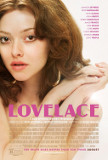Lovelace (United States, 2013)
August 11, 2013
Creating a bio-pic of Linda Lovelace (nee Boreman) comes with its own series of challenges. The chief of these is that no one, not even Lovelace (who died in 2002), has a consistent view of the salient facts of her life. So, basing a movie on her story requires some judicious picking-and-choosing of who to believe and which elements to excise. Many people know, or think they know, Lovelace's tale, but it's not quite as straightforward as what was described on The Phil Donahue Show. Lovelace's name appears on four autobiographies: two "pro-porn" (Inside Linda Lovelace and The Intimate Diary of Linda Lovelace) and two "anti-porn" (Ordeal and Out of Bondage). In the years prior to her death, Lovelace claimed the earlier two books were actually written by her then-husband, Chuck Traynor, and the latter two tell the real story. Eyewitness accounts are divided over whether Linda's porn career was more Inside Linda Lovelace or Ordeal. Therein lies the conundrum.
Screenwriter Andy Bellin has found a way to resolve this, although its dramatic viability is an open question. He has essentially written two different films and fused them together. The first chronicles Linda's story from about 1970 to 1974 much as is related in Inside Linda Lovelace. He then hits the reset button and re-tells the same events with an Ordeal slant. While this solves some of the thorny issues associated with the massive inconsistencies, it introduces another problem by failing to develop a psychologically compelling portrait of the main character. Too often, this feels like a made-for-TV biography (albeit one with all sorts of "adult content" added to spice it up). The strategy that allows it to represent multiple viewpoints disallows Linda to gain true three-dimensionality. It also reduces Chuck Traynor to a one-dimensional monster. There are some great individual scenes that show the kind of dramatic potential inherent in this story. One moment that stands out is when Linda has a late-night conversation with her dad and he reveals that he saw Deep Throat. The actors, Amanda Seyfried and Robert Patrick, play the scene perfectly and it's genuinely heartbreaking. Unfortunately, most of Lovelace is more generic and familiar, right down to the too-neat happy ending.
For roughly its first half, Lovelace feels like watered-down Boogie Nights. Its insights into the porn industry and effective re-creation of the 1970s give it value. During this part of the film, Linda (Seyfried) comes closest to becoming a fully rounded character. She exudes girl-next-door sensuality. The recreations of Deep Throat are tastefully done and there's some intentional humor. Hints abound that something's amiss (bruises on Linda's leg being a first indication). Peter Sarsgaard's Chuck is the perfect mix of smarmy seduction and controlling psychopath. During Lovelace's second act, however, Linda becomes a pure victim and Chuck devolves into a conscienceless fiend. Depth and complexity are tossed aside - a fatal flaw for a movie that wants to be taken seriously.
The actors can't be faulted for any of Lovelace's missteps. Amanda Seyfried commits fully to the role, offering the requisite nudity one would expect from the project and doing a sufficiently credible job that we forget how much more attractive she is than Linda. Seyfried is excellent in some scenes but she is ultimately defeated by the limitations of the screenplay. During the second half, she has little opportunity to do more than cower and look pathetic. Likewise, Peter Sarsgaard is on his way to developing Chuck into a great villain when the movie forces a black hat onto his head and has him twirl his mustache. Taking away Traynor's humanity and making him a cartoonish embodiment of evil is one of several missteps.
An unrecognizable Sharon Stone and Robert Patrick do consistently solid work as Linda's mother and father. We leave the film thinking how much more interesting the story might have been if told from their point-of-view. We've seen lots of movies about the rise and fall of porn stars but how often have we seen how it impacts their families? We get a bit of that here but not nearly enough. Chris Noth plays a sympathetic financier. His appearance would have been more noteworthy had Sarah Jessica Parker's scenes escaped the editor's scissors. (She filmed some material, none of which made it into the finished movie.) There are some high-profile cameos: James Franco is miscast (and downright awful) as Hugh Hefner; Hank Azaria is amusing as Deep Throat's director, Gerry Damiano; and Eric Roberts, Wes Bentley, and Chloe Sevigny have blink-and-you'll-miss-them appearances.
The co-directors are documentarians Rob Epstein & Jeffrey Friedman (this is their second feature film). Their background probably explains the meticulous attention to detail paid to the period - everything looks great. The film doesn't rely exclusively on era-specific pop songs, outdated clothing, and outrageous hairstyles (although all are in play) to recreate the '70s. Those who make documentaries are often fascinated by differing perspectives, and this may explain why they were attracted to the unconventional structure of the narrative. Unfortunately, while Lovelace is never boring, it fails to clear the hurdle necessary for a bio-pic to be more than a fleshed-out version of what one can read on Wikipedia.
Lovelace (United States, 2013)
Cast: Amanda Seyfried, Peter Sarsgaard, Sharon Stone, Robert Patrick, Juno Temple, Chris Noth
Screenplay: Andy Bellin
Cinematography: Eric Alan Edwards
Music: Stephen Trask
U.S. Distributor: Radius-TWC
U.S. Release Date: 2013-08-09
MPAA Rating: "R" (Sexual Content, Nudity, Profanity, Violence, Drugs)
Genre: DRAMA
Subtitles: none
Theatrical Aspect Ratio: 2.35:1

Comments